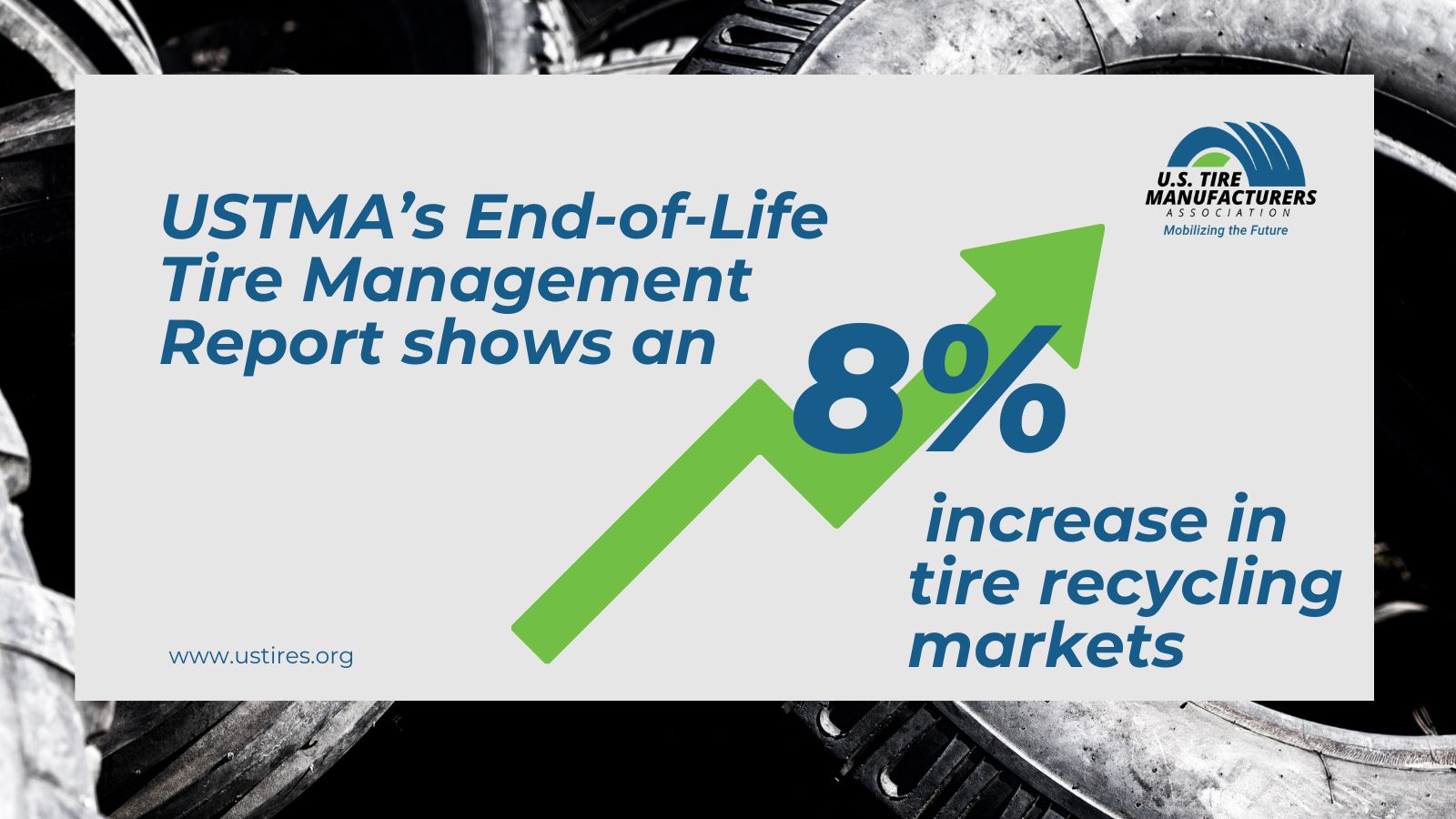The Strategic Roadmap for End-of-Life Tire Management
January 16, 2025
The tire industry has taken great strides in sustainability, proactively driving innovative solutions to transform End-of-Life Tires (ELTs) into a valuable resource. While tires are one of the most recycled and reclaimed products in the U.S. understanding and addressing the lifecycle of tires is paramount for environmental stewardship and innovation. The U.S. Tire Manufacturers Association’s (USTMA) 2023 End-of-Life Tire Management Report, the only in-depth report of its kind, highlights the latest market trends and insights, and outlines opportunities for advancing sustainable and circular end-use markets for tires. We have received essential insights through collaboration with our partners, including all 50 states, over 30 End-of-Life tire recyclers, numerous tire-derived material consumers, industry experts, and related associations.
Understanding End-of-Life Tires
The End-of-Life Tire market is comprised of automotive tires that have reached the end of their operational life and can no longer be safely used on vehicles. More than 230 million end-of-life (ELT) tires are generated each year, and the management of ELTs has been a priority for USTMA members for three decades. In 2023, 79% of End-of-Life Tires were reclaimed or recycled, an 8% increase from 71% in 2021. USMTA members share the goal that 100% of ELT’s enter sustainable and circular markets which is why the Association works with stakeholders and industry partners to incentivize market development and federal and state regulations that foster tire recycling markets.

Tire-derived fuel, used by cement kilns, pulp and paper mills, and utility boilers is the largest reclamation and recycling market for End-of-Life Tires (33%). Ground rubber is the second largest market, making up about 28% of End-of-Life Tires in 2023. Ground rubber is used in a range of applications, including rubberized asphalt for roads, reflecting the growing demand for sustainable materials in infrastructure and everyday products. However, building broader, more innovative tire recycling and reclamation markets to meet the annual generation of End-of-Life Tires is an ongoing challenge.
While substantial progress has been achieved, the tire industry continues to drive advancements in the circular economy through strategic investments in recycling technologies, expanding end-use markets, and fostering collaboration. A key example of this leadership is the creation of the Tire Recycling Foundation (TRF), a joint initiative by the U.S. Tire Manufacturers Association and the Tire Industry Association, which actively champions innovation and sustainable solutions across the industry. TRF is committed to securing funding and allocating grants for research, education, intervention and demonstration projects targeting critical gaps within the tire recycling supply chain across the United States.
Emerging Markets and Sustainable Solutions
The tire industry is fueling a remarkable transformation, pioneering breakthrough approaches that reimagine End-of-Life Tires while providing economic value and supporting the circular economy. Thanks to investments from the Bipartisan Infrastructure Law and the Inflation Reduction Act, there is enormous potential for the development of innovative end-use markets to ensure that tire recycling remains a cornerstone of U.S. sustainability efforts.
Rubber-Modified Asphalt
Rubber-Modified Asphalt (RMA) is a mixture of ground tire rubber with asphalt that provides proven economic, environmental and performance benefits in building better, longer-lasting roads and highways. The RMA market grew 17% from 2021 to 2023, consuming about 165,000 tons of ELTs. It is one of the most promising end-of-life tire applications, as asphalt is one of the most recycled materials and can be used indefinitely. This approach offers multiple benefits including:
- Improved road durability and extended pavement life
- Reduced road maintenance costs
- Reduced life-cycle costs
- Improved vehicle fuel economy (leading to reduced greenhouse gas emissions)
- Reduced tire wear vs. concrete
Tire-Derived Aggregate
Tire-derived aggregate (TDA) represents another innovative end-use market, using recycled tire materials as a cost-effective infill material for stormwater infiltration galleries. It also provides significant benefits in reducing pollutants entering stormwater in urban areas. Galleries made with tire-derived aggregate reduce stormwater pollutants while being light weight and having more water volume-capture potential.
USTMA will release a tire-derived aggregate state of knowledge report this year, offering data-driven insights to support market growth and innovation in this market.
Achieving 100% Tire Circularity: A Call to Action:
USTMA has long been a strong proponent of collaborative industry problem-solving efforts, especially for complex, multi-stakeholder problems such as fully eliminating illegal and abandoned tire stockpiles and creating sustainable, circular markets for 100% of End-of-Life Tires. The Tire Recycling Foundation is one key stakeholder in this ecosystem, contributing critical support through the research and development of innovative recycling technologies for End-of-Life Tires.
No single entity can solve this challenge alone. It requires a holistic, integrated approach that connects manufacturers, recyclers, state and federal governments, regulatory bodies and environmental groups in a comprehensive circular ecosystem. USTMA continues to urge Congress to use rubber-modified asphalt in federal road projects and fund research for both RMA and tire-derived aggregate. The ongoing research and development of end-use markets will drive economic and environmental sustainability in the tire industry and the communities we serve.
While the challenge can be complex, the mission is simple: Ensuring that 100% of End-of-Life Tires enter sustainable end-use markets.
